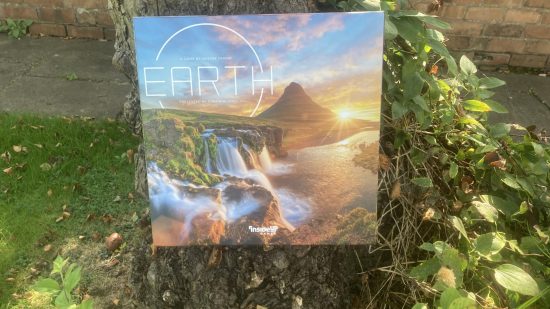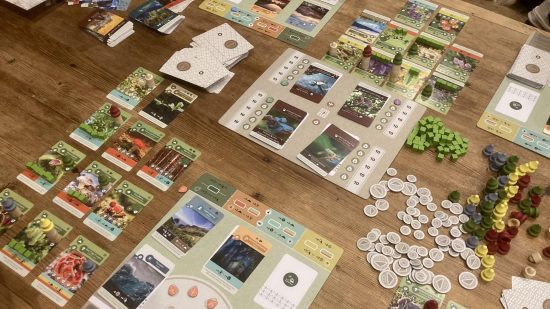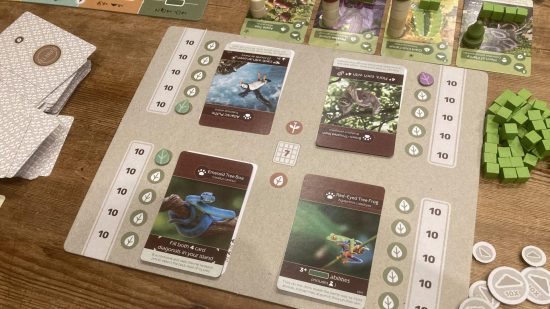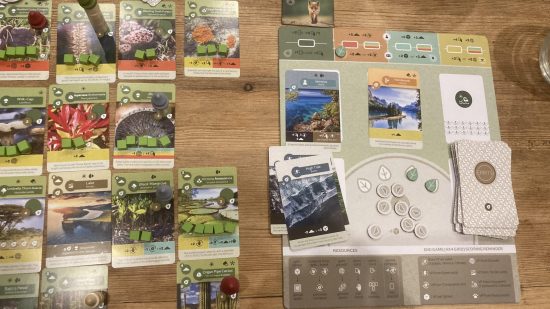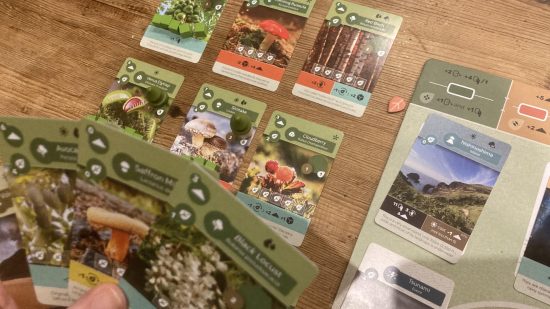Our Verdict
Earth is a fast-paced engine builder board game with an innovative approach that cuts out any waiting around for your turn. It's got a great theme and is full of variety and complex decision making.
Earth is an engine building board game about crafting an island and filling it with plants. It teems with variety. In one game you’ll encounter dozens of cards featuring all kinds of flora. You’ll cover them in all sorts of wooden bits to score oodles of points, and maybe make a sloth or ladybug happy in the process.
The game is a tableau builder. You plop plants and terrain down in a four by four grid, and you’re finished once someone’s island is complete. On each player’s turn, they’ll pick one of four actions: Planting, Composting, Watering, or Growing, and this will gain all players different resources, then activate the powers of particular plants, depending on which color-coded option was selected.
As with all engine-builders, Earth starts out relatively simple, but before long you’re drowning in cards and soil (plant money – naturally), discarding from your over-large hand into the compost, then turning all that compost into as many growth rings and shoots as your blossoming ecosystem can handle.
| Publisher | Inside Up Games |
| Players | 1-5 |
| Play time | 45-90 minutes |
| Recommended ages | 13+ |
The neatest thing about Earth, and what drew me to it initially, is its simultaneous turns. Unusually for this genre, Earth has virtually no down time. On each player’s turn, everyone gets rewarded by the chosen action (the active player gets more from it), and everyone activates the plants in their tableau on every single turn.
There are certainly some downsides to this, but since the worst thing about engine builders (where there’s generally little you can do to impact another player) is waiting for someone else to finish fiddling about with their board, it’s a massively positive change on the whole. There’s no waiting around at all in Earth!
It creates a non-stop… thrill ride is the wrong term. Earth is not the sort of game where you’ll stop and punch the air or tensely chew your lip waiting to see if a move will pay off. It’s more accurate to say it creates an extremely smooth experience, where you’re constantly having fun, constantly taking action, while also trying to think about your next move and plot a course. It also makes the game very quick to play. Despite its reasonable complexity, you can teach and play a game of Earth in just a couple of hours.
Earth is very much a point salad game, where there’s all sorts of ways to score, and trying to have a completely optimal game would drive you to despair. These range from attracting one of four animals (selected at the start from a much larger bestiary) with different conditions, to playing expensive cards, to endgame adjacency bonuses, to discarding cards into your compost pile.
My favorite is the canopies. Each plant can grow to a certain height, represented by wooden trunks, and once it’s completed you cap it off with a wooden canopy for a score bonus. These come in four different colors – not for any mechanical reason, just to look cute!
What’s interesting, and goes some way to making Earth feel like a real ecosystem, is the way all the game’s resources and point scoring methods feed into and off one another. To succeed in Earth, it’s no good focusing on just one scoring method – you’ll soon run out of spaces to put sprout cubes or growth pieces. Instead, Earth is all about building a system that turns one thing into another, and your job is to try and keep a balance, recycling what you’ve built and ensuring minimum wastage.
For instance, you might play some mushroom plants that have the power to reduce your compost to create growth. But then you’ll want to lay something else that converts that growth into card draw, so you can use another plant that turns those cards into more compost… and so on and so forth.
There’s always lots of choices to make, right from the word go, which means analysis paralysis can be a factor with Earth. In fact, the first thing the game asks of you is to draw a bunch of cards and dump half of them into the compost, and since there are no dreadful cards in Earth, you might immediately feel a little out of your depth.
The lack of downtime also means there’s no breathing room – not much of a chance to stop and take stock. But in the course of a game – where, because of the simultaneous turns, you’re always doing so much – you soon enter a sort of flow, where you’re not too hung up on any one card, because you know that five more will come along in just a minute.
Earth’s theme is rich, and it’s definitely a good-looking game. More so than its bright colors and pretty pictures of plants though, I like the way the mechanics often fit the cards themselves. You win the sloth if you get tall trees; the glacier terrain scores points for other cold cards in straight lines; and you can spend growth instead of soil to pay the costs of parasitic plants. I find this sort of thing immensely satisfying.
While it’s one of Earth’s greatest successes, I should say that one of the main downsides of acting on each other’s turns is that it reduces the interaction you have with the other people at your table, as everyone always needs to concentrate. And when the game already has basically zero mechanics for player interaction, at times you do feel you could almost be playing a solo board game.
Wingspan is probably the closest comparison I can find to Earth (check out our Wingspan review to why we love that game). I think Earth is probably the better designed board game of the two, for cutting out the wait time and the sheer variety of interesting cards it has on offer. But I also think that for many gamers it won’t replace Wingspan’s spot at the table, simply because they’ll be looking for a less full-on experience with more downtime where you can stop and have a chat. (Also Earth, despite a good theme, can’t compare to Wingspan on the cosiness front).
Overall, Earth is a game we can heartily recommend for most. A clever puzzle with a good theme that doesn’t outstay its welcome, it’s great for players who hate downtime, enjoy a lot of variety in their games, and aren’t easily daunted by strategy board games with plenty of decision making.
It’s a must-try for any fans of engine builders or people who like figuring out how to get the most value out of card interactions. The only reason you might want to stay clear is if for you, board games are a social experience above all else, and a game with little interactivity and less room for table talk than average has low appeal, even if it’s great fun mechanically. For the rest, Earth’s up!
